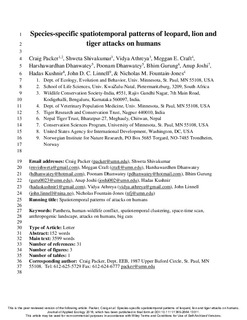| dc.contributor.author | Packer, Craig | |
| dc.contributor.author | Shivakumar, Shweta | |
| dc.contributor.author | Athreya, Vidya | |
| dc.contributor.author | Craft, Meggan E. | |
| dc.contributor.author | Dhanwatey, Harshawardhan | |
| dc.contributor.author | Dhanwatey, Poonam | |
| dc.contributor.author | Gurung, Bhim | |
| dc.contributor.author | Joshi, Anup | |
| dc.contributor.author | Kushnir, Hadas | |
| dc.contributor.author | Linnell, John Durrus | |
| dc.contributor.author | Fountain-Jones, Nicholas M. | |
| dc.date.accessioned | 2019-01-28T11:11:50Z | |
| dc.date.available | 2019-01-28T11:11:50Z | |
| dc.date.created | 2019-01-10T12:34:17Z | |
| dc.date.issued | 2018 | |
| dc.identifier.issn | 0021-8901 | |
| dc.identifier.uri | http://hdl.handle.net/11250/2582594 | |
| dc.description.abstract | 1. Large carnivores of the genus Panthera can pose serious threats to public safety. Although the annual number of attacks on humans is rare compared to livestock depredation, such incidents undermine popular support for wildlife conservation and require immediate responses to protect human life. 2. We used a space–time scan method to perform a novel spatiotemporal analysis of 908 attacks on humans by lions, leopards, and tigers to estimate the risks of further attacks in the same locales. 3. We found that a substantial proportion of attacks were clustered in time and space, but the dimension of these outbreaks varied between species. Lion outbreaks included more human fatalities, persisted for longer periods of time, and extended over larger areas than tiger or leopard outbreaks. 4. Synthesis and applications. Our analysis reveals the typical spatiotemporal patterns of past lion, leopard, and tiger attacks on humans. In future, this technique could be used by relevant agencies to warn local people of risks from further attacks within a certain time and distance following an initial incident by each species. Furthermore, the approach can help identify areas requiring management interventions to address such threats. anthropogenic landscape, attacks on humans, big cats, human–wildlife conflict, Panthera,space–time scan, spatiotemporal clustering | nb_NO |
| dc.description.abstract | Species-specific spatiotemporal patterns of leopard, lion and tiger attacks on humans | nb_NO |
| dc.language.iso | eng | nb_NO |
| dc.subject | anthropogeniclandscape | nb_NO |
| dc.subject | attacksonhumans | nb_NO |
| dc.subject | big cats | nb_NO |
| dc.subject | human-wildlifw conflict | nb_NO |
| dc.subject | Panthera | nb_NO |
| dc.subject | space–timescan | nb_NO |
| dc.subject | spatiotemporalclustering | nb_NO |
| dc.title | Species-specific spatiotemporal patterns of leopard, lion and tiger attacks on humans | nb_NO |
| dc.type | Journal article | nb_NO |
| dc.type | Peer reviewed | nb_NO |
| dc.description.version | acceptedVersion | nb_NO |
| dc.rights.holder | © 2018 The Authors. Journal of Applied Ecology © 2018 British Ecological Society | nb_NO |
| dc.subject.nsi | VDP::Zoologiske og botaniske fag: 480 | nb_NO |
| dc.subject.nsi | VDP::Zoology and botany: 480 | nb_NO |
| dc.source.journal | Journal of Applied Ecology | nb_NO |
| dc.identifier.doi | 10.1111/1365-2664.13311 | |
| dc.identifier.cristin | 1654030 | |
| dc.relation.project | Andre: National Science Foundation | nb_NO |
| cristin.unitcode | 7511,2,0,0 | |
| cristin.unitname | Avdeling for terrestrisk økologi | |
| cristin.ispublished | true | |
| cristin.fulltext | postprint | |
| cristin.qualitycode | 2 | |
